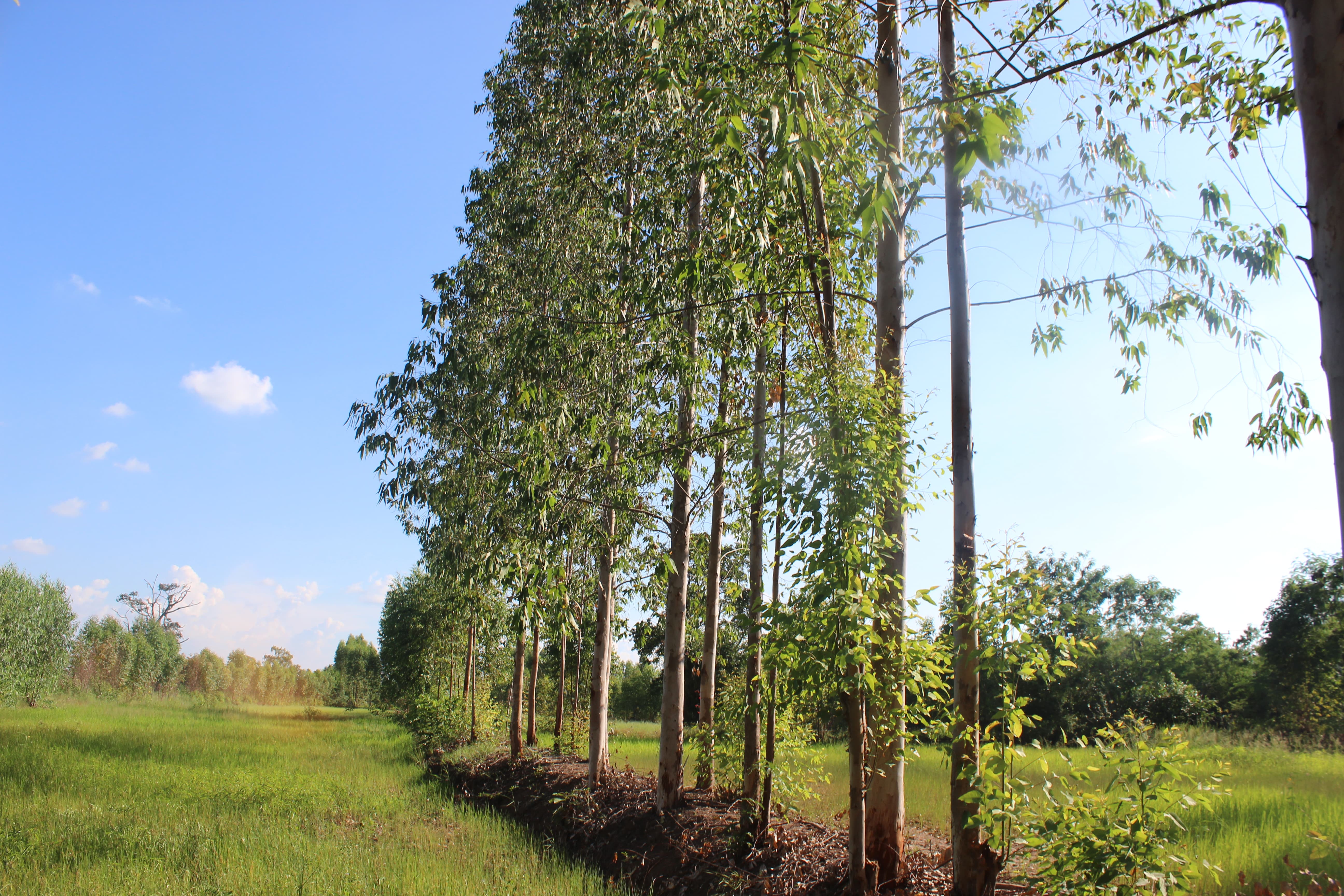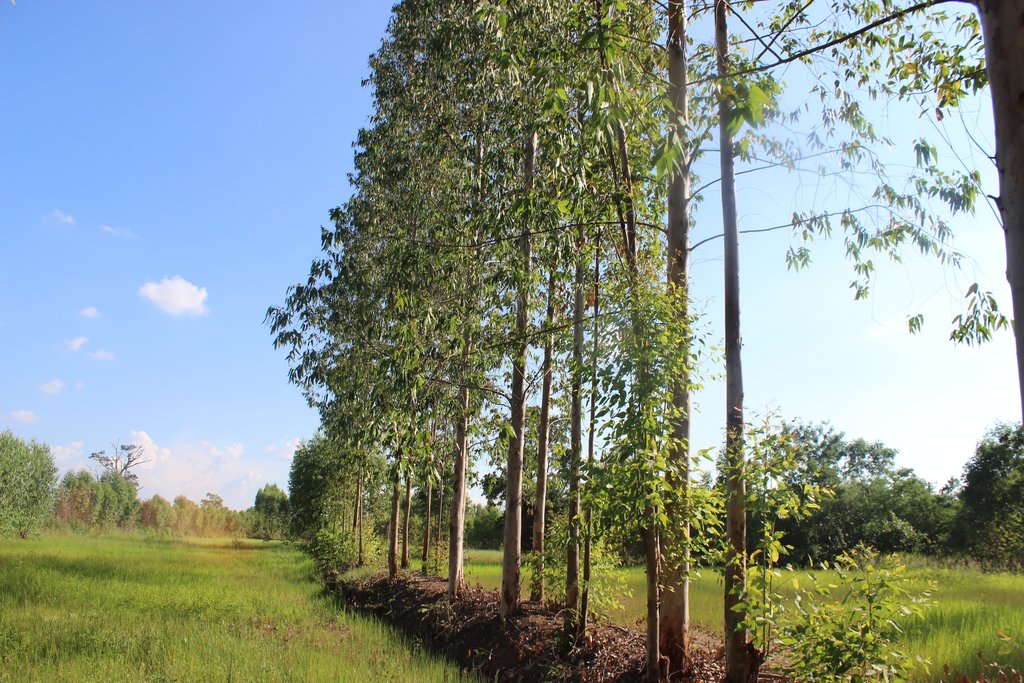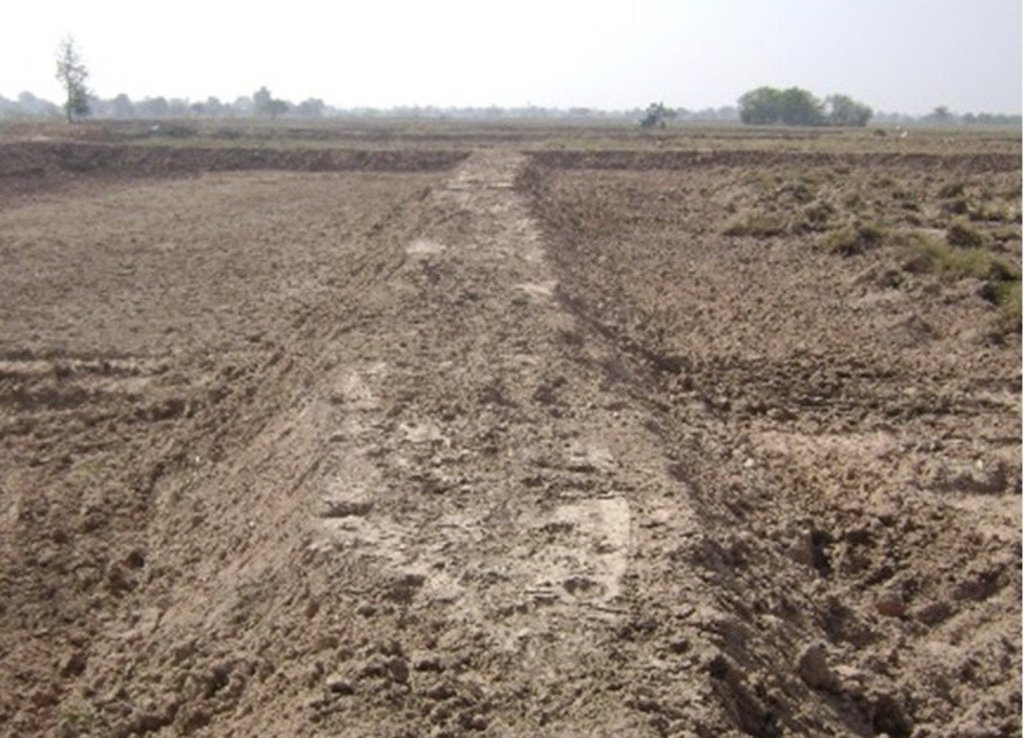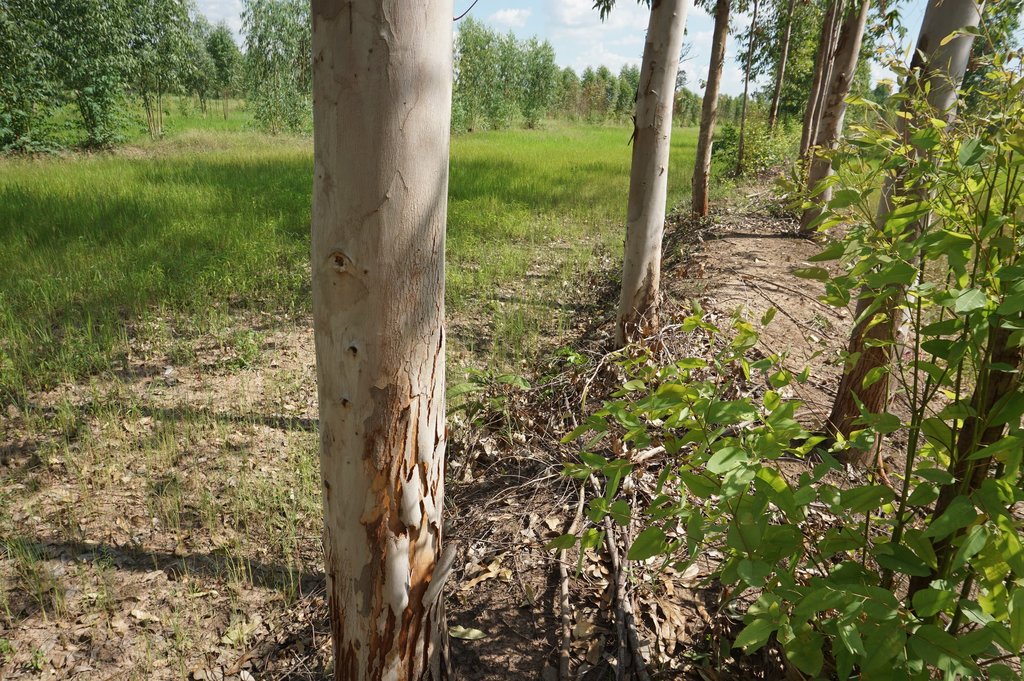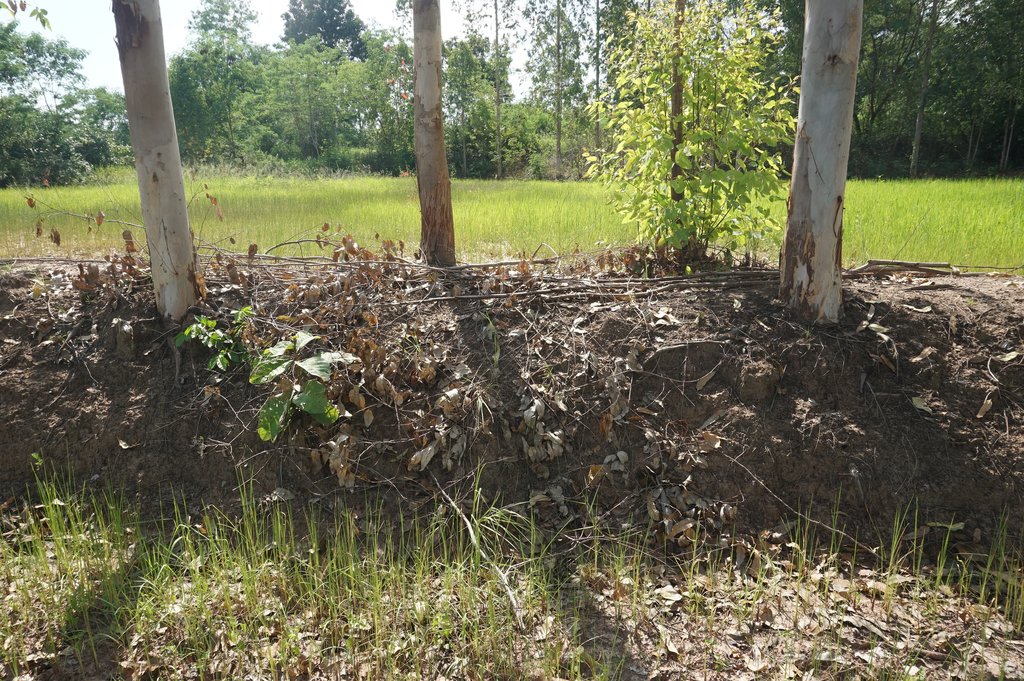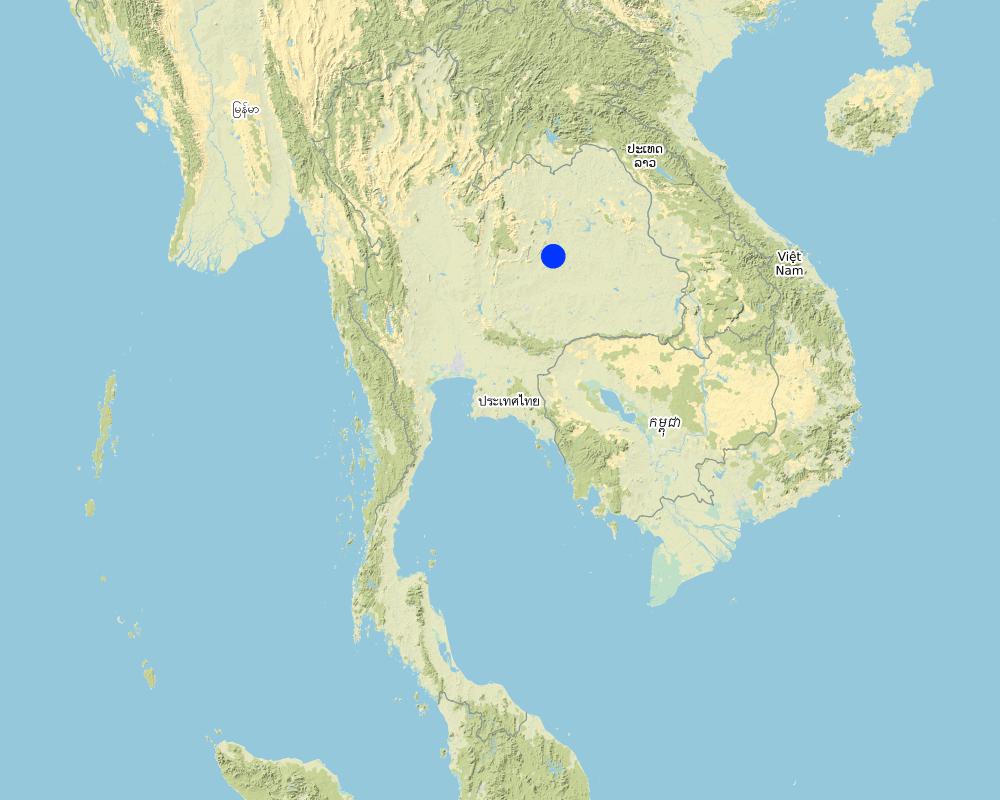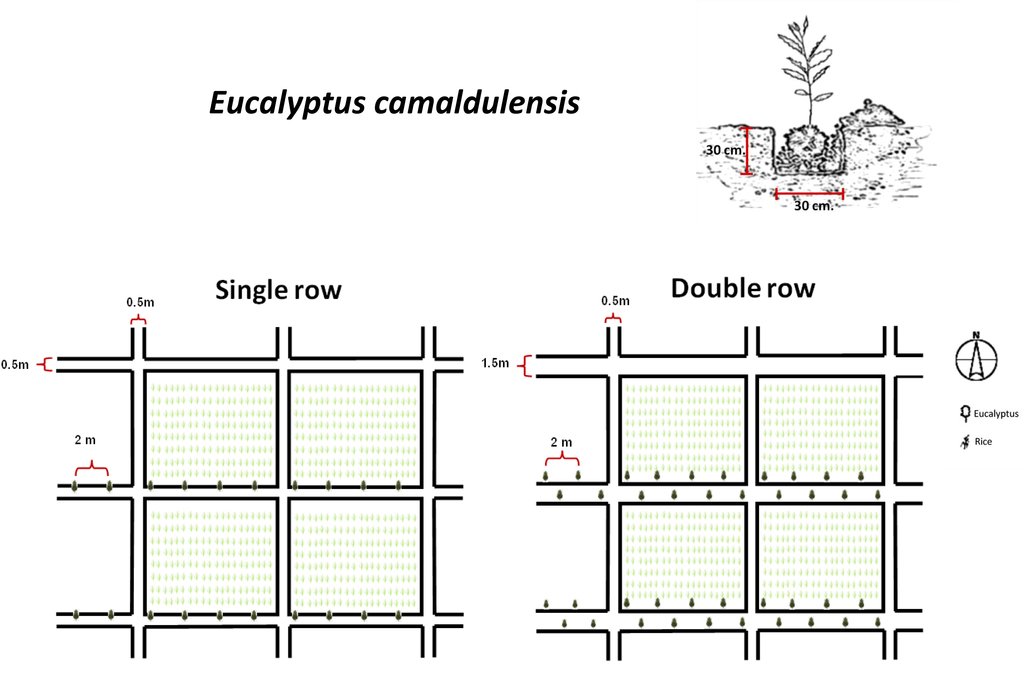Planting Eucalyptus on rice bunds to lower saline groundwater [ប្រទេសថៃ]
- ការបង្កើត៖
- បច្ចុប្បន្នភាព
- អ្នកចងក្រង៖ Areerat Wangkaew
- អ្នកកែសម្រួល៖ –
- អ្នកត្រួតពិនិត្យច្រើនទៀត៖ Rima Mekdaschi Studer, Samran Sombatpanit, Pitayakon Limtong, William Critchley
Planting perennial salt-tolerant trees in salt-affected areas of the Northeast of Thailand.
technologies_4099 - ប្រទេសថៃ
ពិនិត្យមើលគ្រប់ផ្នែក
ពង្រីកមើលទាំងអស់ បង្រួមទាំងអស់1. ព័ត៌មានទូទៅ
1.2 ព័ត៌មានលម្អិតពីបុគ្គលសំខាន់ៗ និងស្ថាប័នដែលចូលរួមក្នុងការវាយតម្លៃ និងចងក្រងឯកសារនៃបច្ចេកទេស
បុគ្គលសំខាន់ម្នាក់ (ច្រើននាក់)
អ្នកប្រើប្រាស់ដី:
Chuenchai Sayan
+66-99-0254108
Ban Muang Pia, Muang Pia Sub-district, Ban Phai District, Khon Kaen 40110
ប្រទេសថៃ
អ្នកជំនាញឯកទេស SLM:
Sritumboon Supranee
ssritumboon@yahoo.com
Land Development Department
2003, 61 Phaholyothin Road, Ladyao, Chatuchak, Bangkok 10900
ប្រទេសថៃ
អ្នកជំនាញឯកទេស SLM:
Pothinam Pornpana
laosuwan18@hotmail.com
Land Development Department
2003, 61 Phaholyothin Road, Ladyao, Chatuchak, Bangkok 10900
ប្រទេសថៃ
អ្នកជំនាញឯកទេស SLM:
Rophandung Weera
weerop@hotmail.com
Land Development Department
2003, 61 Phaholyothin Road, Ladyao, Chatuchak, Bangkok 10900
ប្រទេសថៃ
អ្នកជំនាញឯកទេស SLM:
Srihaban Pranee
pranee.782@gmail.com
Land Development Department
2003, 61 Phaholyothin Road, Ladyao, Chatuchak, Bangkok 10900
ប្រទេសថៃ
អ្នកជំនាញឯកទេស SLM:
Jakkarach Usa
usa.kl@hotmail.com
Land Development Department
2003, 61 Phaholyothin Road, Ladyao, Chatuchak, Bangkok 10900
ប្រទេសថៃ
អ្នកជំនាញឯកទេស SLM:
Janplang Chettaruj
joeshua9@hotmail.com
Land Development Department
2003, 61 Phaholyothin Road, Ladyao, Chatuchak, Bangkok 10900
ប្រទេសថៃ
National consultant:
Arunin Somsri
ssarunin@gmail.com
Land Development Department
2003, 61 Phaholyothin Road, Ladyao, Chatuchak, Bangkok 10900
ប្រទេសថៃ
ឈ្មោះគម្រោងដែលបានចងក្រងឯកសារ/ វាយតម្លៃលើបច្ចេកទេស (បើទាក់ទង)
Decision Support for Mainstreaming and Scaling out Sustainable Land Management (GEF-FAO / DS-SLM)ឈ្មោះអង្គភាពមួយ (ច្រើន) ដែលបានចងក្រងឯកសារ/ វាយតម្លៃបច្ចេកទេស (បើទាក់ទង)
Land Development Department LDD (Land Development Department LDD) - ប្រទេសថៃ1.3 លក្ខខណ្ឌទាក់ទងទៅនឹងការប្រើប្រាស់ទិន្នន័យដែលបានចងក្រងតាមរយៈ វ៉ូខេត
តើពេលណាដែលទិន្នន័យបានចងក្រង (នៅទីវាល)?
01/10/2018
អ្នកចងក្រង និង(បុគ្គលសំខាន់ៗ)យល់ព្រមទទួលយកនូវលក្ខខណ្ឌនានាទាក់ទងទៅនឹងការប្រើប្រាស់ទិន្នន័យដែលបានចងក្រងតាមរយៈវ៉ូខេត:
បាទ/ចា៎
1.4 សេចក្តីប្រកាសស្តីពីចីរភាពនៃការពណ៌នាពីបច្ចេកទេស
តើបច្ចេកទេសដែលបានពណ៌នានេះមានបញ្ហាដែលផ្តោតលើការធ្លាក់ចុះគុណភាពដី, បើដូច្នេះវាមិនអាចត្រូវបានប្រកាសថាជាបច្ចេកទេសនៃការគ្រប់គ្រងប្រកបដោយចីរភាពទេ?
ទេ
មតិយោបល់:
The technology is environmentally suited and very well accepted by the land users.
1.5 ការយោងទៅលើកម្រងបញ្ជីសំណួរនៃវិធីសាស្ត្រផ្សព្វផ្សាយ SLM
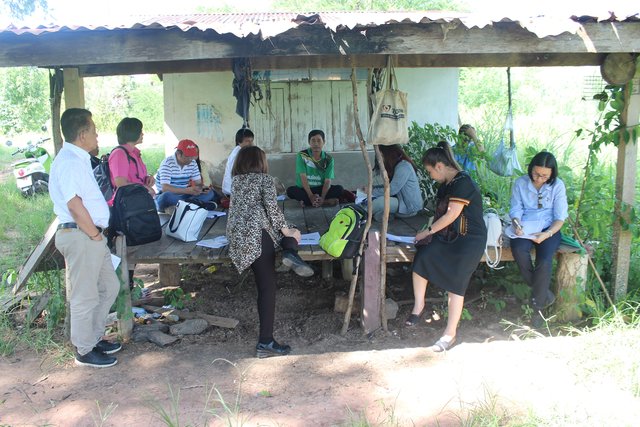
Advisory system for planting Eucalyptus camaldulensis on rice … [ប្រទេសថៃ]
The Thai government promotes planting of Eucalyptus camaldulensis on rice bunds to lower the saline groundwater level and prevent the spread of salt in soils - through cooperation of farmers, land owners, Siam Forestry Co., Ltd., Subdistrict Administration Organization, Land Development Department, and with specialists/ technical advisors.
- អ្នកចងក្រង៖ Areerat Wangkaew
2. ការពណ៌នាពីបច្ចេកទេស SLM
2.1 ការពណ៌នាដោយសង្ខេបពីបច្ចេកទេស
និយមន័យបច្ចេកទេស:
Eucalyptus camaldulensis variety H4 is salt tolerant and has the ability to lower shallow saline groundwater levels; as a result salinity is controlled. Planting eucalyptus on one or two sides of the rice bund in an east-west direction (in single or double rows) at a spacing of 2 m between trees is the most effective technique and well accepted by farmers.
2.2 ការពណ៌នាលម្អិតពីបច្ចេកទេស
ការពណ៌នា:
Eucalyptus camaldulensis cultivation on rice bunds to lower shallow saline groundwater levels in low-lying areas is a technology used on salt-affected land. The LDD Perennial Tree Planting project to promote the technology of planting Eucalyptus camaldulensis on rice bunds has been implemented since 1996. The land user interviewed cultivates a moderately salt-affected rice field at Ban Muang Pia District, Khon Kaen Province. The land is used for rice production both glutinous (variety RD 6) and non-glutinous fragrant rice (Hom Mali 105). The average yield of rice is 200-250 kg/rai (1 ha = 6.25 rai). The farmers have planted eucalyptus on bunds in the rice cultivated areas on about 10,000 rai in more than 10 years with the objectives of remedying and preventing salination by lowering shallow saline groundwater levels, through "bio-drainage" as well as increasing income and better utilization of lands on rice bunds for growing trees.
The technology of eucalyptus cultivation on rice bunds has been implemented in farmers' fields in the low-lying salt-affected rice area common in the Northeast of Thailand. It is widely accepted by farmers through the joint partnership between the Land Development Department (LDD), Siam Forestry Co., Ltd. and the local district administration. Eucalyptus seedlings are provided by LDD and are planted in a single or double rows - double rows with trees planted on two sides of the rice bunds in a zigzag manner following an east-west direction to prohibit a shadow effect. The spacing between the trees in a row is 2 m: the rice bund was adapted to be 1.5 m wide and 0.5 m high. This provides more space and convenient access to the rice field. The project provides labour costs for farmers to prepare the land before planting. Many farmers outside the project transplanted their own eucalyptus seedlings on the bunds of 0.5 m or more in width. Farmers buy the seedlings at 1 THB each and plant in pits of 0.3 x 0.3 x 0.3 m with 0.5 kg compost and 0.5 kg rice husks from farm by-products. This technology is well accepted by farmers because of the effective control of salinity in the rice fields as well as the higher income obtained from selling eucalyptus wood. Farmers observed the dead patchy spots of rice plants with salt crusts before planting eucalyptus: after 2 cutting cycles no salt patches were observed anymore, and rice yields increased noticeably. There was also extra income from selling poles of eucalyptus every 4 years. The average yield of eucalyptus trees of 2.5-3.0 inches in diameter was 16 tons per rai for the first cutting.
Based on 7 years (2 crops of eucalyptus coppicing), the average additional income was 1,087 THB/rai/yr (according to the farmers' and Siam Forest's information). The main investment was in the first year of planting; later on, the maintenance cost was on labour for weeding, pruning and thinning to 3 stems after coppice/cutting, including adding 15-15-15 fertilizer for each tree. The average income is increased through better rice yields. The benefits of the technology according to interviews are creating a cooler microclimate from eucalyptus trees and changes in biodiversity through better soil quality resulting in more species of flora and fauna such as grasses, wildflowers, dragonflies, earthworms in the rice field and on the bund. Some farmers wanted more trees by planting at closer spacing of 1 m, but this resulted in too great a density of trees thus consuming more surface water and competing with rice for water consumptive use.
2.3 រូបភាពនៃបច្ចេកទេស
2.4 វីដេអូនៃបច្ចេកទេស
ការពណ៌នាសង្ខេប:
The video shows the area of eucalyptus growing on the rice bund.
កាលបរិច្ឆេទ:
01/10/2018
ទីតាំង:
Ban Muang Pia, Khon Kaen
ឈ្មោះអ្នកថតវីឌីអូ:
Supranee Sritumboon
ការពណ៌នាសង្ខេប:
Farmer interview and SLM discussion.
កាលបរិច្ឆេទ:
01/10/2018
ទីតាំង:
Ban Muang Pia, Khon Kaen
ឈ្មោះអ្នកថតវីឌីអូ:
Supranee Sritumboon
2.5 ប្រទេស/តំបន់/ទីតាំងកន្លែង ដែលបច្ចេកទេសត្រូវបានអនុវត្ត និងបានគ្រប់ដណ្តប់ដោយការវាយតម្លៃនេះ
ប្រទេស:
ប្រទេសថៃ
តំបន់/រដ្ឋ/ខេត្ត:
Khon Kaen
បញ្ជាក់បន្ថែមពីលក្ខណៈនៃទីតាំង:
Ban Phai
មតិយោបល់:
The SLM Technology site for planting eucalyptus in a rice production area.
Map
×2.6 កាលបរិច្ឆេទនៃការអនុវត្ត
បង្ហាញឆ្នាំនៃការចុះអនុវត្ត:
1996
2.7 ការណែនាំពីបច្ចេកទេស
សូមបញ្ជាក់តើបច្ចេកទេសត្រូវបានណែនាំឱ្យអនុវត្តដោយរបៀបណា:
- តាមរយៈគម្រោង / អន្តរាគមន៍ពីខាងក្រៅ
- by other land users
មតិយោបល់ (ប្រភេទនៃគម្រោង ។ល។):
The project initiated by the government (Land Development Department) collaborated with private enterprises (Siam Forestry Co., Ltd.), local administration, communities and land users.
3. ចំណាត់ថ្នាក់នៃបច្ចេកទេស SLM
3.1 គោលបំណងចម្បង (១ ឬច្រើន) នៃបច្ចេកទេសនេះ
- ធ្វើឱ្យប្រសើរឡើងនូវផលិតកម្ម
- កាត់បន្ថយ, បង្ការ, ស្តារឡើងវិញនូវការធ្លាក់ចុះគុណភាពដី
- អភិរក្ស/ធ្វើឱ្យប្រសើរឡើងជីវចម្រុះ
- បង្កើតផលប្រយោជន៍សេដ្ឋកិច្ច
3.2 ប្រភេទដីប្រើប្រាស់មួយប្រភេទ (ច្រើនប្រភេទ) ដែលបានអនុវត្តបច្ចេកទេស

ដីដាំដំណាំ
- ដំណាំប្រចាំឆ្នាំ
- ដំណាំរយៈពេលវែង (មិនមែនឈើ)
ដំណាំចម្បង (ដំណាំកសិ-ឧស្សាហកម្ម និងដំណាំស្បៀង) :
Rice
មតិយោបល់:
Planting eucalyptus for additional income and more intensive utilization of land on the rice bunds.
ប្រសិនបើដីមានការប្រែប្រួលបន្ទាប់ពីការអនុវត្តបច្ចេកទេស សូមបញ្ជាក់ពីការប្រើប្រាស់ដីមុនពេលអនុវត្តន៍បច្ចេកទេស:
Before planting eucalyptus, rice was the only crop. Due to the shallow saline groundwater of the area, rice had shown symptoms of being salt-affected; however after planting eucalyptus trees, these symptoms disappeared.
3.3 ព័ត៌មានបន្ថែមអំពីអ្នកប្រើប្រាស់ដី
ការផ្គត់ផ្គង់ទឹកនៅកន្លែងអនុវត្តបច្ចេកទេស:
- ទឹកភ្លៀង
មតិយោបល់:
Average annual rainfall is 1,200-1,300 mm.
ចំនួនសារដែលដាំដំណាំក្នុងមួយឆ្នាំ:
- 1
សូមបញ្ជាក់:
Land use is for rice production; the technology is planting Eucalyptus camaldulensis on rice bunds.
ដង់ស៊ីតេនៃសត្វចិញ្ចឹម (បើពាក់ព័ន្ធ):
Only few cattle, swine, and boar are in the land user's farm.
3.4 ក្រុម SLM ដែលបច្ចេកទេសស្ថិតនៅក្នុង
- កសិរុក្ខកម្ម
- ការគ្រប់គ្រងទឹកក្រោមដី
- desalination
3.5 ការសាយភាយនៃបច្ចេកទេស
បញ្ជាក់ពីការសាយភាយនៃបច្ចេកទេស:
- ត្រូវបានផ្សព្វផ្សាយត្រឹមតំបន់មួយ
ប្រសិនបើបច្ចេកទេសត្រូវបានសាយភាយពាសពេញតំបន់ណាមួយ សូមកំណត់ទំហំផ្ទៃដីអនុវត្តន៍:
- 1-10 គម2
មតិយោបល់:
The technology has spread over the area of 10,000 rai (1 ha = 6.25 rai) owned by farmers/land users both under and outside the supported project of planting eucalyptus on rice bunds.
3.6 វិធានការ SLM ដែលបញ្ចូលនូវបច្ចេកទេស

វិធានការក្សេត្រសាស្ត្រ
- A2: សារធាតុសរីរាង្គ/ជីជាតិដី
- A5: ការគ្រប់គ្រងគ្រាប់ពូជ បង្កើនប្រភេទពូជ

វិធានការផ្សេងៗ
មតិយោបល់:
Eucalyptus camaldulensis H4 is the salt-tolerant variety used for lowering shallow saline groundwater.
3.7 កំណត់ប្រភេទនៃការធ្លាក់ចុះគុណភាពដីសំខាន់ៗដែលបច្ចេកទេសនេះបានដោះស្រាយ

ការធ្លាក់ចុះសារធាតុគីមីក្នុងដី
- Cn: ការថយចុះជីជាតិ និងកាត់បន្ថយបរិមាណសារធាតុសរីរាង្គ (មិនកើតឡើងដោយការហូរច្រោះទេ)
- Cs: សារធាតុប្រៃ/អាល់កាឡាំង

ការបាត់បង់រូបសាស្ត្រនៃដី
- Pc: ការហាប់ណែន
- Pk: ការបិទរន្ធដី

ការធ្លាក់ចុះជីវសាស្ត្រនៃដី
- Bc: ការថយចុះនូវគម្របរុក្ខជាតិ
- Bq: ការថយចុះនូវជីវម៉ាស/ បរិមាណ
- Bs: សមាសភាពដែលមានគុណភាពនិងប្រភេទសត្វ/ការថយចុះនូវជីវចម្រុះ
- Bl: ការបាត់បង់មីក្រូ និងម៉ាក្រូសរីរាង្គរបស់ដី

ការបាត់បង់ទឹក
- Hg: ការប្រែប្រួលបរិមាណទឹកនៅក្រោមដី
- Hq: ការថយចុះគុណភាពទឹកនៅក្រោមដី
3.8 ការពារ កាត់បន្ថយ ឬស្តារឡើងវិញនៃការធ្លាក់ចុះគុណភាពដី
បញ្ជាក់ពីគោលដៅរបស់បច្ចេកទេស ដែលផ្តោតទៅការធ្លាក់ចុះគុណភាពដី:
- ការកាត់បន្ថយការធ្លាក់ចុះគុណភាពដី
- ការជួសជុល/ ស្តារឡើងវិញនៃឱនភាពដីធ្ងន់ធ្ងរ
មតិយោបល់:
Decreased saline groundwater levels to control salinity distribution in rice cultivated areas.
4. បច្ចេកទេសជាក់លាក់ សកម្មភាពអនុវត្ត ធាតុចូល និងថ្លៃដើម
4.1 គំនូសបច្ចេកទេសនៃបច្ចេកទេសនេះ
4.2 លក្ខណៈពិសេសនៃបច្ចេកទេស/ ពណ៌នាពីគំនូរបច្ចេកទេស
1. Seedling of Eucalyptus camaldulensis H4, a salt-tolerant variety, were planted. The age of seedlings was 3-month old. The rice bund was regulated to 0.5 m wide for planting eucalyptus in single row or 1.5 m wide for planting in double rows (in a zigzag manner), 0.5 m high with a spacing of 2 m between the trees along an east-west direction. The number of trees was 80/rai or 500/ha for double rows planting.
2. Planting technique: 0.5 kg of compost mixed with 0.5 kg of rice husks was applied at the bottom of a pit of 0.3 x 0.3 x 0.3 m before seedlings were planted.
4.3 ព័ត៌មានទូទៅដែលពាក់ព័ន្ធនឹងការគណនាធាតុចូល និងថ្លៃដើម
កំណត់របៀបនៃការគណនាថ្លៃដើម និងធាតុចូល:
- ក្នុងតំបន់អនុវត្តបច្ចេកទេស
កំណត់ទំហំ និងឯកត្តាផ្ទៃដី:
own by one selected land user
បើសិនប្រើឯកតាតាមផ្ទៃដីក្នុងមូលដ្ឋាន សូមបញ្ជាក់ពីខ្ជាតប្តូរទៅជាហិកតា:
1 hectare = 6.25 rai
ផ្សេងៗ/ រូបិយប័ណ្ណជាតិ (បញ្ជាក់):
THB
កំណត់អត្រាប្តូរប្រាក់ពីដុល្លាទៅរូបិយប័ណ្ណតំបន់ (បើទាក់ទង)៖ 1 ដុល្លារ =:
32,0
កំណត់ថ្លៃឈ្នួលជាមធ្យមនៃការជួលកម្លាំងពលកម្មក្នុងមួយថ្ងៃ:
300 THB
4.4 សកម្មភាពបង្កើត
| សកម្មភាព | ប្រភេទវិធានការ | ពេលវេលា | |
|---|---|---|---|
| 1. | Site selection of salt-affected area | រចនាសម្ព័ន្ធ | May-July |
| 2. | Land preparation; bunds construction and seedling preparation | រចនាសម្ព័ន្ធ | May-July |
| 3. | Public hearing, joint meeting between farmers and researchers | ផ្សេងៗ | May-July |
| 4. | Demonstration plot | ក្សេត្រសាស្ត្រ | May-July |
| 5. | Model establishment (Eucalyptus planting method) | ក្សេត្រសាស្ត្រ | May-July |
| 6. | Joint monitoring, evaluation and follow up for planting | ផ្សេងៗ | After planting |
មតិយោបល់:
No irrigation water therefore the planting time depends on the period of early rainy season which will be from May to July.
4.5 ថ្លៃដើម និងធាតុចូលដែលត្រូវការសម្រាប់ការបង្កើតបច្ចេកទេស
| បញ្ជាក់ពីធាតុចូល | ឯកតា | បរិមាណ | ថ្លៃដើមក្នុងមួយឯកតា | ថ្លៃធាតុចូលសរុប | % នៃថ្លៃដើមដែលចំណាយដោយអ្នកប្រើប្រាស់ដី | |
|---|---|---|---|---|---|---|
| កម្លាំងពលកម្ម | Labour cost for planting eucalyptus (labour wage per day = 300 THB, 1 rai required a labour cost of 600 THB) | Rai | 1,0 | 600,0 | 600,0 | |
| សម្ភារៈដាំដុះ | Eucalyptus seedling cost (80 trees/rai), 1 THB for each seedling | Seedling | 80,0 | 1,0 | 80,0 | |
| ជី និងសារធាតុពុល | Compost cost 3.5 THB/kg, 0.5 kg/pit | kg | 40,0 | 3,5 | 140,0 | |
| ជី និងសារធាតុពុល | Rice husk cost 4 THB/kg, 0.5 kg/pit | kg | 40,0 | 4,0 | 160,0 | |
| ថ្លៃដើមសរុបក្នុងការបង្កើតបច្ចេកទេស | 980,0 | |||||
ប្រសិនបើអ្នកប្រើប្រាស់ដីមិនមានថ្លៃដើម 100% សូមបញ្ជាក់ថានរណាដែលចំណាយថ្លៃដើមដែលនៅសល់:
Land Development Department
មតិយោបល់:
Labour cost for land preparation and planting borne by LDD and seedlings borne by Siam Forestry Co., Ltd.; compost and rice husk were from farm by-products.
4.6 សកម្មភាពថែទាំ
| សកម្មភាព | ប្រភេទវិធានការ | ពេលវេលា/ ភាពញឹកញាប់ | |
|---|---|---|---|
| 1. | Thinning and pruning after first year of planting | ក្សេត្រសាស្ត្រ | 2 times/rain season |
| 2. | Weeding after first year of planting | ក្សេត្រសាស្ត្រ | 2 times/rain season |
| 3. | Fertilizer application after first year of planting | ក្សេត្រសាស្ត្រ | 2 times/rain season |
| 4. | Cutting and selling logs | ក្សេត្រសាស្ត្រ | 4th and 7th year |
មតិយោបល់:
Four years after planting, the poles will be cut and sold. After cutting, the tree coppices, then thinning is needed in order to leave not more than 3 stems, necessary for better growth of the tree trunks. Weeding is important during rainy season to control competition for fertilizer.
4.7 កំណត់ថ្លៃដើមសម្រាប់ការថែទាំ/ សកម្មភាពរបស់បច្ចេកទេស (ក្នុងរយៈពេលមួយឆ្នាំ)
| បញ្ជាក់ពីធាតុចូល | ឯកតា | បរិមាណ | ថ្លៃដើមក្នុងមួយឯកតា | ថ្លៃធាតុចូលសរុប | % នៃថ្លៃដើមដែលចំណាយដោយអ្នកប្រើប្រាស់ដី | |
|---|---|---|---|---|---|---|
| កម្លាំងពលកម្ម | Labour cost of weeding, pruning, thinning, and fertilizer application for 150 THB/time, 2 times/rai/yr, based on the labour wage of 300 THB/day | Time | 2,0 | 150,0 | 300,0 | |
| ជី និងសារធាតុពុល | Cost of 15-15-15 chemical fertilizer (13 THB/kg, application rate 50 g/tree; 50 g x 80 trees per rai = 4 kg/rai | kg | 4,0 | 13,0 | 52,0 | |
| ថ្លៃដើមសរុបសម្រាប់ការថែទាំដំណាំតាមបច្ចេកទេស | 352,0 | |||||
មតិយោបល់:
Land users do the job by themselves without hiring labourers. Furthermore, the fertilizer application will be the same fertilizer and timing as is used for rice. No extra fertilizer needed for trees because the trees will consume fertilizer from the rice field.
4.8 កត្តាសំខាន់បំផុតដែលមានឥទ្ធិពលដល់ការចំណាយ
ពណ៌នាពីកត្តាប៉ះពាល់ចម្បងៗទៅលើថ្លៃដើម:
Maintenance cost of weeding, pruning, thinning and fertilizer application was 428 THB/rai/yr. Calculation is based on 7 years of planting. Four years after planting, the logs were sold for additional income 5,714.3 THB/rai. On the 7th year, the logs were sold at 4,285.7 THB/rai.
(Income from 2 times of Eucalyptus sale; 4th year = 40,000 THB, 7th year = 30,000 THB. Therefore, total income for 7 years = 10,000 THB/rai. Benefit from Eucalyptus planting = 10,000–2,388 (planting cost + 4 years of maintenance cost) = 7,612 THB/7 years = 1,087 THB/rai/yr.)
Compost and rice husk are from farm by-products and the labour costs are from land users. The income thereore will be higher than 1,087 THB/rai as estimated.
5. លក្ខណៈបរិស្ថានធម្មជាតិ និងមនុស្ស
5.1 អាកាសធាតុ
បរិមាណទឹកភ្លៀងប្រចាំឆ្នាំ
- < 250 មម
- 251-500 មម
- 501-750 មម
- 751-1,000 មម
- 1,001-1,500 មម
- 1,501-2,000 មម
- 2,001-3,000 មម
- 3,001-4,000 មម
- > 4,000 មម
កំណត់បរិមាណទឹកភ្លៀង (បើដឹង) ជា មីលីម៉ែត្រ:
1200,00
លក្ខណៈពិសេស/ មតិយោបល់លើរដូវភ្លៀង:
Average annual rainfall from 2003-2012
បញ្ជាក់ឈ្មោះឯកសារយោងនៃស្ថានីយឧតុនិយម:
Meteorological Department
តំបន់កសិអាកាសធាតុ
- មានភ្លៀងតិចតួច
Average temperature 21-36 degree Celsius, relative humidity is 75%
5.2 សណ្ឋានដី
ជម្រាលជាមធ្យម:
- រាបស្មើ (0-2%)
- ជម្រាលតិចតួច (3-5%)
- មធ្យម (6-10%)
- ជម្រាលខ្ពស់បន្តិច (11-15%)
- ទីទួល (16-30%)
- ទីទួលចោត (31-60%)
- ទីទួលចោតខ្លាំង (>60%)
ទម្រង់ដី:
- ខ្ពង់រាប
- កំពូលភ្នំ
- ជម្រាលភ្នំ
- ជម្រាលទួល
- ជម្រាលជើងភ្នំ
- បាតជ្រលងភ្នំ
តំបន់តាមរយៈកម្ពស់ :
- 0-100 ម
- 101-500 ម
- 501-1,000 ម
- 1,001-1,500 ម
- 1,501-2,000 ម
- 2,001-2,500 ម
- 2,501-3,000 ម
- 3,001-4,000 ម
- > 4,000 ម
បញ្ជាក់ថាតើបច្ចេកទេសនេះត្រូវបានអនុវត្តន៍នៅក្នុង:
- មិនពាក់ព័ន្ធទាំងអស់
មតិយោបល់ និងបញ្ចាក់បន្ថែមអំពីសណ្ឋានដី :
The geography is in the lower basin of Korat Plateau in the Northeast of Thailand.
5.3 ដី
ជម្រៅដីជាមធ្យម:
- រាក់ខ្លាំង (0-20 សម)
- រាក់ (21-50 សម)
- មធ្យម (51-80 សម)
- ជ្រៅ (81-120 សម)
- ជ្រៅខ្លាំង (> 120 សម)
វាយនភាពដី (ស្រទាប់លើ):
- គ្រើម/ មានពន្លឺ (ខ្សាច់)
វាយនភាពដី (> 20 សម ស្រទាប់ក្នុង):
- មធ្យម (ល្បាយ, ល្បាប់)
សារធាតុសរីរាង្គនៅស្រទាប់ដីខាងលើ:
- ទាប (<1%)
បើអាចសូមភ្ជាប់ការពណ៌នាពីដីឱ្យបានច្បាស់ ឬព័ត៌មានដែលអាចទទួលបាន ឧ. ប្រភេទដី, pH ដី/ ជាតិអាស៊ីត, សមត្ថភាពផ្លាស់ប្តូរកាចុង, វត្តមាននីត្រូសែន, ភាពប្រៃ ។ល។:
Texture of top soil is sandy loam and more than 20 cm below the surface is sandy clay loam; pH = 7 and increasing with depth up to 8.5; soil salinity is moderately to highly affected which is identified by the salt crusts on the soil surface; very low P and K.
5.4 ទឹកដែលអាចទាញមកប្រើប្រាស់បាន និងគុណភាពទឹក
នីវ៉ូទឹកក្រោមដី:
< 5 ម
ទឹកលើដីដែលអាចទាញយកប្រើប្រាស់បាន:
មិនមាន/ គ្មាន
គុណភាពទឹក (មិនបានធ្វើប្រត្តិកម្ម):
ទឹកពិសារដែលគ្មានគុណភាព (តម្រូវឱ្យមានការសំអាត)
តើមានបញ្ហាភាពទឹកប្រៃហូរចូលមកដែរឬទេ?
បាទ/ចា៎
សូមបញ្ជាក់:
Slightly saline
តើទឹកជំនន់កំពុងកើតមាននៅតំបន់នេះដែររឺទេ?
ទេ
មតិយោបល់ និងលក្ខណៈពិសេសផ្សេងៗទៀតលើគុណភាព និងបរិមាណទឹក :
Shallow saline groundwater exists because of the low-lying discharge area and the source of the salt is under the surface of the land.
5.5 ជីវៈចម្រុះ
ភាពសម្បូរបែបនៃប្រភេទ:
- ទាប
ភាពសម្បូរបែបនៃទីជម្រក:
- ទាប
មតិយោបល់ និងលក្ខណៈពិសេសផ្សេងទៀតលើជីវចម្រុះ:
Before planting eucalyptus, species and habitat were low. After 7 years, dragonfly, earthworms, birds, rats, and wildflowers that were not seen before now are found.
5.6 លក្ខណៈនៃអ្នកប្រើប្រាស់ដីដែលអនុវត្តបច្ចេកទេស
នៅមួយកន្លែង ឬពនេចរ :
- នៅមួយកន្លែង
ទីផ្សារនៃប្រព័ន្ធផលិតកម្ម:
- ពាក់កណ្តាលពាណិជ្ជកម្ម (ផ្គត់ផ្គង់ខ្លួនឯង/ ពាណិជ្ជកម្ម
ចំណូលក្រៅកសិកម្ម:
- 10-50% នៃចំណូល
កម្រិតជីវភាព:
- មធ្យម
ឯកជន ឬក្រុម:
- ធ្វើខ្លួនឯង/ គ្រួសារ
កម្រិតប្រើប្រាស់គ្រឿងយន្ត:
- ប្រើកម្លាំងពលកម្ម
យេនឌ័រ:
- បុរស
អាយុរបស់អ្នកប្រើប្រាស់ដី:
- មនុស្សចាស់
សូមបញ្ជាក់ពីលក្ខណៈពាក់ព័ន្ធផ្សេងទៀតអំពីអ្នកប្រើប្រាស់ដី:
Diligent farmer seeking more income by raising few cattle, swine, and boar.
5.7 ទំហំផ្ទៃដីជាមធ្យមនៃដីផ្ទាល់ខ្លួន ឬជួលគេដែលបានអនុវត្តបច្ចេកទេស
- < 0.5 ហិកតា
- 0.5-1 ហិកតា
- 1-2 ហិកតា
- 2-5 ហិកតា
- 5-15 ហិកតា
- 15-50 ហិកតា
- 50-100 ហិកតា
- 100-500 ហិកតា
- 500-1,000 ហិកតា
- 1,000-10,000 ហិកតា
- > 10,000 ហិកតា
តើផ្ទៃដីនេះចាត់ទុកជាទំហំកម្រិតណាដែរ ខ្នាតតូច មធ្យម ឬខ្នាតធំ (ធៀបនឹងបរិបទតំបន់)?
- ខ្នាតតូច
មតិយោបល់:
Farmers/ land owners outside the project have been planting eucalyptus on rice bunds and get additional income.
5.8 ភាពជាម្ចាស់ដី កម្មសិទ្ធប្រើប្រាស់ដី និងកម្មសិទ្ធប្រើប្រាស់ទឹក
ភាពជាម្ចាស់ដី:
- ឯកជន មានកម្មសិទ្ធ
កម្មសិទ្ធិប្រើប្រាស់ដី:
- ឯកជន
- rainfed
5.9 ការប្រើប្រាស់សេវាកម្ម និងហេដ្ឋារចនាសម្ព័ន្ធ
សុខភាព:
- មិនល្អ
- មធ្យម
- ល្អ
ការអប់រំ:
- មិនល្អ
- មធ្យម
- ល្អ
ជំនួយបច្ចេកទេស:
- មិនល្អ
- មធ្យម
- ល្អ
ការងារ (ឧ. ការងារក្រៅកសិដ្ឋាន):
- មិនល្អ
- មធ្យម
- ល្អ
ទីផ្សារ:
- មិនល្អ
- មធ្យម
- ល្អ
ថាមពល:
- មិនល្អ
- មធ្យម
- ល្អ
ផ្លូវ និងការដឹកជញ្ជូន:
- មិនល្អ
- មធ្យម
- ល្អ
ទឹកផឹក និងអនាម័យ:
- មិនល្អ
- មធ្យម
- ល្អ
សេវាកម្មហិរញ្ញវត្ថុ:
- មិនល្អ
- មធ្យម
- ល្អ
6. ផលប៉ះពាល់ និងការសន្និដ្ឋាន
6.1 ផលប៉ះពាល់ក្នុងបរិវេណអនុវត្តបច្ចេកទេសដែលកើតមាន
ផលប៉ះពាល់លើសេដ្ឋកិច្ចសង្គម
ផលិតផល
ផលិតកម្មដំណាំ
គុណភាពមុន SLM:
Rice production before planting eucalyptus 150-200 kg/rai
គុណភាពក្រោយ SLM:
Rice production after planting eucalyptus 200-250 kg/rai
មតិយោបល់/ ការបញ្ជាក់:
The increase in rice production was due to being less saline condition of the field.
គុណភាពដំណាំ
គុណភាពមុន SLM:
More unfilled grain of rice
គុណភាពក្រោយ SLM:
Less unfilled grain of rice
មតិយោបល់/ ការបញ្ជាក់:
Increased about 10%
ផលិតកម្មចំណីសត្វ
គុណភាពមុន SLM:
Less stubble
គុណភាពក្រោយ SLM:
More stubble
មតិយោបល់/ ការបញ្ជាក់:
Increased about 10%
ផលិតកម្មសត្វ
គុណភាពក្រោយ SLM:
10%
ភាពសម្បូរបែបនៃផលិតផល
គុណភាពមុន SLM:
Only rice was grown before SLM
គុណភាពក្រោយ SLM:
Rice and Eucalyptus
មតិយោបល់/ ការបញ្ជាក់:
Increased about 50%, Eucalyptus grown in east-west direction only.
ផ្ទៃដីផលិតកម្ម
គុណភាពមុន SLM:
0%
គុណភាពក្រោយ SLM:
50%
មតិយោបល់/ ការបញ្ជាក់:
Rice bunds were unused before planting eucalyptus.
ការគ្រប់គ្រងដី
គុណភាពមុន SLM:
0%
គុណភាពក្រោយ SLM:
10%
មតិយោបល់/ ការបញ្ជាក់:
Planting trees hinder access to the rice field.
ទឹកដែលអាចទាញមកប្រើប្រាស់បាន និងគុណភាពទឹក
គុណភាពទឹកបរិភោគ
គុណភាពក្រោយ SLM:
No effect
មតិយោបល់/ ការបញ្ជាក់:
From rain water
ទឹកដែលអាចប្រើប្រាស់បានសម្រាប់ការចិញ្ចឹមសត្វ
មតិយោបល់/ ការបញ្ជាក់:
Depend upon rainfall
គុណភាពទឹកសម្រាប់ការចិញ្ចឹមសត្វ
មតិយោបល់/ ការបញ្ជាក់:
Depends upon rain water
ទឹកប្រើប្រាស់សម្រាប់ស្រោចស្រព
មតិយោបល់/ ការបញ្ជាក់:
No supplementary water available
គុណភាពទឹកស្រោចស្រព
មតិយោបល់/ ការបញ្ជាក់:
Under rainfed only
តម្រូវការទឹកសម្រាប់ស្រោចស្រព
មតិយោបល់/ ការបញ្ជាក់:
Remain unchanged
ចំណូល និងថ្លៃដើម
ការចំណាយលើធាតុចូលកសិកម្ម
គុណភាពមុន SLM:
0%
គុណភាពក្រោយ SLM:
20%
មតិយោបល់/ ការបញ្ជាក់:
Increased about 20% (the cost for planting trees in the first year and the maintenance cost of later years).
ចំណូលក្នុងកសិដ្ឋាន
គុណភាពមុន SLM:
0
គុណភាពក្រោយ SLM:
Approximately 1,000 THB/rai/yr
មតិយោបល់/ ការបញ្ជាក់:
Additional income from selling eucalyptus logs besides rice
ភាពសម្បូរបែបប្រភពប្រាក់ចំណូល
គុណភាពមុន SLM:
Income from only rice
គុណភាពក្រោយ SLM:
Income from both rice and logs
មតិយោបល់/ ការបញ្ជាក់:
Extra income from selling swine and boar
បន្ទុកការងារ
គុណភាពមុន SLM:
0%
គុណភាពក្រោយ SLM:
10%
មតិយោបល់/ ការបញ្ជាក់:
Increased about 10% by planting tree and subsequent maintainence.
ផលប៉ះពាល់ទៅលើវប្បធម៌សង្គម
សន្តិសុខស្បៀង/ ភាពគ្រប់គ្រាន់ខ្លួនឯង
គុណភាពមុន SLM:
0%
គុណភាពក្រោយ SLM:
10%
មតិយោបល់/ ការបញ្ជាក់:
Self-sufficiency increased through obtaining higher income.
ស្ថានភាពសុខភាព
គុណភាពមុន SLM:
0%
គុណភាពក្រោយ SLM:
10%
មតិយោបល់/ ការបញ្ជាក់:
Change in microclimate affected in cooler atmosphere
ឱកាសនៃការបង្កើតថ្មី
គុណភាពមុន SLM:
0%
គុណភាពក្រោយ SLM:
10%
មតិយោបល់/ ការបញ្ជាក់:
Due to change in microclimate and biodiversity
ស្ថាប័នសហគមន៍
គុណភាពមុន SLM:
0%
គុណភាពក្រោយ SLM:
20%
មតិយោបល់/ ការបញ្ជាក់:
More communication among land users community and local administration.
ស្ថាប័នជាតិ
គុណភាពមុន SLM:
0%
គុណភាពក្រោយ SLM:
10%
មតិយោបល់/ ការបញ្ជាក់:
National institutions are more recognized by land users.
ចំណេះដឹង SLM / ការធ្លាក់ចុះគុណភាពដី
គុណភាពមុន SLM:
0%
គុណភាពក្រោយ SLM:
50%
មតិយោបល់/ ការបញ្ជាក់:
Land users observed less salination.
ផលប៉ះពាល់ទៅលើអេកូឡូស៊ី
វដ្តទឹក/លំហូរ
ប្រព័ន្ធបង្ហូរទឹក
គុណភាពមុន SLM:
0%
គុណភាពក្រោយ SLM:
10%
មតិយោបល់/ ការបញ្ជាក់:
Saline groundwater level decreased due to the bio-drainage by eucalyptus trees.
នីវ៉ូទឹកក្រោមដី/ ដង្ហើមទឹក
គុណភាពមុន SLM:
Ave. groundwater level < 1 m
គុណភាពក្រោយ SLM:
Ave. groundwater level > 1 m
មតិយោបល់/ ការបញ្ជាក់:
Lower groundwater level after 7 years of planting eucalyptus
រំហួត
គុណភាពមុន SLM:
0%
គុណភាពក្រោយ SLM:
10%
មតិយោបល់/ ការបញ្ជាក់:
Cooler atmosphere
ដី
សំណើមដី
គុណភាពមុន SLM:
0%
គុណភាពក្រោយ SLM:
10%
មតិយោបល់/ ការបញ្ជាក់:
Due to shading
គម្របដី
គុណភាពមុន SLM:
0%
គុណភាពក្រោយ SLM:
10%
មតិយោបល់/ ការបញ្ជាក់:
Shading effect and plant residues
ដីប្រេះ
គុណភាពមុន SLM:
0%
គុណភាពក្រោយ SLM:
10%
មតិយោបល់/ ការបញ្ជាក់:
Due to better soil properties from crop residues and earthworm activities
ដីហាប់
គុណភាពមុន SLM:
0%
គុណភាពក្រោយ SLM:
10%
មតិយោបល់/ ការបញ្ជាក់:
Due to better soil properties from crop residues and earthworm activities
វដ្តនៃសារធាតុចិញ្ចឹម/ការទទួលបាន
គុណភាពមុន SLM:
0%
គុណភាពក្រោយ SLM:
10%
ភាពប្រៃ
គុណភាពមុន SLM:
0%
គុណភាពក្រោយ SLM:
30%
មតិយោបល់/ ការបញ្ជាក់:
Rice production as well as quality of rice increased (and also more percentage of full grains) due to the decrease in salinity level.
ជីវចម្រុះ៖ ដំណាំ, សត្វ
ដំណាំគម្រប
គុណភាពមុន SLM:
0%
គុណភាពក្រោយ SLM:
50%
មតិយោបល់/ ការបញ្ជាក់:
Rice bunds are used for planting eucalyptus only along east-west direction.
ជីវម៉ាស/ កាបូនលើដី
គុណភាពមុន SLM:
0%
គុណភាពក្រោយ SLM:
80%
មតិយោបល់/ ការបញ្ជាក់:
Biomass from eucalyptus trees
ភាពសម្បូរបែបនៃរុក្ខជាតិ
គុណភាពមុន SLM:
0%
គុណភាពក្រោយ SLM:
60%
មតិយោបល់/ ការបញ្ជាក់:
From eucalyptus trees and more local species of grasses and wildflowers
ភាពសម្បូរបែបនៃសត្វ
គុណភាពមុន SLM:
0%
គុណភាពក្រោយ SLM:
50%
មតិយោបល់/ ការបញ្ជាក់:
Earthworms, birds, rats, ants, etc.
ប្រភេទសត្វមានប្រយោជន៍
គុណភាពមុន SLM:
0%
គុណភាពក្រោយ SLM:
10%
មតិយោបល់/ ការបញ្ជាក់:
Native earthworms
ភាពសម្បូរបែបនៃទីជំរក
គុណភាពមុន SLM:
0%
គុណភាពក្រោយ SLM:
20%
មតិយោបល់/ ការបញ្ជាក់:
Dragonfly, earthworms, birds and rats
ការកាត់បន្ថយហានិភ័យនៃគ្រោះមហន្តរាយ និងគ្រោះអាកាសធាតុ
ផលប៉ះពាល់នៃគ្រោះរាំងស្ងួត
គុណភាពមុន SLM:
0%
គុណភាពក្រោយ SLM:
10%
មតិយោបល់/ ការបញ្ជាក់:
Due to cooler atmosphere of the planting sites
ការបំភាយនៃកាបូន និងឧស្ម័នផ្ទះកញ្ចក់
គុណភាពមុន SLM:
0%
គុណភាពក្រោយ SLM:
20%
មតិយោបល់/ ការបញ្ជាក់:
Eucalyptus trees absorb greenhouse gases.
អាកាសធាតុ
គុណភាពមុន SLM:
0%
គុណភាពក្រោយ SLM:
20%
មតិយោបល់/ ការបញ្ជាក់:
Cooler and greener atmosphere
6.2 ផលប៉ះពាល់ក្រៅបរិវេណអនុវត្តបច្ចេកទេសដែលកើតមាន
ទឹកក្រោមដី/ ការបំពុលទឹកទន្លេ
គុណភាពមុន SLM:
0%
គុណភាពក្រោយ SLM:
10%
មតិយោបល់/ ការបញ្ជាក់:
Reduced groundwater level
ផលប៉ះពាល់នៃឧស្ម័នផ្ទះកញ្ចក់
គុណភាពមុន SLM:
0%
គុណភាពក្រោយ SLM:
10%
មតិយោបល់/ ការបញ្ជាក់:
The planted Eucalyptus trees absorb greenhouse gases.
6.3 ភាពប្រឈម និងភាពរួសនៃបច្ចេកទេសទៅនឹងការប្រែប្រួលអាកាសធាតុ និងគ្រោះអាកាសធាតុ/ គ្រោះមហន្តរាយ (ដែលដឹងដោយអ្នកប្រើប្រាស់ដី)
គ្រោះអាកាសធាតុ (មហន្តរាយ)
គ្រោះមហន្តរាយអាកាសធាតុ
| លក្ខណៈឆ្លើយតបនៃបច្ចេកទេសទៅនឹងការប្រែប្រួលអាកាសធាតុ | |
|---|---|
| រាំងស្ងួត | មិនល្អ |
ផលវិបាកដែលទាក់ទងនឹងបរិយាកាសផ្សេងៗទៀត
ផលវិបាកដែលទាក់ទងនឹងបរិយាកាសផ្សេងៗទៀត
| លក្ខណៈឆ្លើយតបនៃបច្ចេកទេសទៅនឹងការប្រែប្រួលអាកាសធាតុ | |
|---|---|
| អូសបន្លាយពេលដាំដុះ | មិនល្អ |
| កាត់បន្ថយពេលដាំដុះ | មិនល្អ |
6.4 ការវិភាគថ្លៃដើម និងអត្ថប្រយោជន៍
តើផលចំណេញ និងថ្លៃដើមត្រូវបានប្រៀបធៀបគ្នាយ៉ាងដូចម្តេច (ទស្សនៈរបស់អ្នកប្រើប្រាស់ដី)?
រយៈពេលខ្លី:
វិជ្ជមានតិចតួច
រយៈពេលវែង:
វិជ្ជមានខ្លាំង
តើផលចំណេញ និងការថែទាំ/ ជួសជុលត្រូវបានប្រៀបធៀបគ្នាយ៉ាងដូចម្តេច (ទស្សនៈរបស់អ្នកប្រើប្រាស់ដី)?
រយៈពេលខ្លី:
វិជ្ជមាន
រយៈពេលវែង:
វិជ្ជមានខ្លាំង
មតិយោបល់:
The cost of planting trees in the first year was the only main cost. The maintenance cost starts from second year on until the year of cutting and selling logs. After coppicing, maintenance cost starts again until the next cutting. Therefore the benefits will be higher with more cycles of cutting.
6.5 ការទទួលយកបច្ចេកទេស
- 10-50%
បើអាច សូមបញ្ជាក់ពីបរិមាណ (ចំនួនគ្រួសារ និង/ ឬតំបន់គ្របដណ្តប់):
1,600 ha
ក្នុងចំណោមគ្រួសារទាំងអស់ដែលអនុវត្តបច្ចេកទេស តើមានប៉ុន្មានគ្រួសារដែលចង់ធ្វើដោយខ្លួនឯង ដោយមិនទទួលបានសម្ភារៈលើកទឹកចិត្ត/ប្រាក់ឧបត្ថម្ភ?:
- 10-50%
មតិយោបល់:
Farmers and land users acknowledge the benefit of the technology that results in decreasing salinity, increasing rice production, and additional income from trees.
6.6 ការបន្សុំា
តើថ្មីៗនេះ បច្ចេកទេសនេះត្រូវបានកែតម្រូវដើម្បីបន្ស៊ាំទៅនឹងស្ថានភាពប្រែប្រួលដែរឬទេ?
បាទ/ចា៎
ផ្សេងៗ (សូមបញ្ជាក់):
closer spacing of trees
បញ្ជាក់ពីការបន្ស៊ាំនៃបច្ចេកទេស (ការរៀបចំ, ឧបករណ៍/ប្រភេទ ។ល។):
Planting eucalyptus has been adapted from growing eucalyptus on rice bunds of 1.5 m wide to 0.5 m wide to save labor cost of land preparation and plant the seedlings on one row instead of 2 rows.
6.7 ភាពខ្លាំង/ គុណសម្បត្តិ/ ឱកាសនៃបច្ចេកទេស
| ភាពខ្លាំង/ គុណសម្បត្តិ/ ឱកាសនៅកន្លែងរបស់អ្នកប្រើប្រាស់ដី |
|---|
| Decrease saline groundwater level resulting in rice yield increase. |
| Get higher income from increasing rice yield and eucalyptus poles. |
| The microclimate in the area has been improved and the air is cooler and the land is greener. |
| Increased indirect returns due to land is greener and used as animal fodders for cattle, swine, and boar. |
| ភាពខ្លាំង/ គុណសម្បត្តិ/ ឱកាស ទស្សនៈរបស់បុគ្គលសំខាន់ៗ |
|---|
| Decreased saline groundwater level then prevented further salination as a result to protect the land degradation. |
| Increasing farmer's income. |
| To establish better environment for more biodiversity especially earthworms used to disappear now are found and their activities induce better soil properties. |
6.8 ភាពខ្សោយ/ គុណវិបត្តិ/ ហានិភ័យនៃបច្ចេកទេស និងវិធីសាស្ត្រដោះស្រាយ
| ភាពខ្សោយ/ គុណវិបត្តិ/ ហានិភ័យ ទស្សនៈរបស់អ្នកប្រើប្រាស់ដី | តើបច្ចេកទេសទាំងនោះបានដោះស្រាយបញ្ហាដូចម្តេច? |
|---|---|
| More birds and rats damage rice yield. | No solution |
| The officers do not visit whenever the land users need help. | The officers need to contact the land users and give advice more often. |
| ភាពខ្សោយ/ គុណវិបត្តិ/ ហានិភ័យ ទស្សនៈរបស់អ្នកចងក្រងឬបុគ្គលសំខាន់ៗ | តើបច្ចេកទេសទាំងនោះបានដោះស្រាយបញ្ហាដូចម្តេច? |
|---|---|
| Farmers do not understand how eucalyptus trees could decrease saline groundwater level. | Explain, illustrate and demonstrate the cause and effect of salinity. |
| There are pros and cons of planting eucalyptus because the leaves may damage the soil and their shading effect may decrease rice yield. | Organize farmer group visit to some successful sites that no adverse effects have been found. |
7. ឯកសារយោង និងវេបសាយ
7.1 វិធីសាស្ត្រ/ ប្រភពនៃព័ត៌មាន
- តាមការចុះទីវាល ការស្រាវជ្រាវនៅទីវាល
Visit 1 farmer/ land user's land
- ការសម្ភាសន៍ជាមួយអ្នកប្រើប្រាស់ដី
Interview with 1 farmer
- ការសម្ភាសន៍ជាមួយអ្នកជំនាញ/ ឯកទេស
The Land Development Department officers and planners (6)
- ការចងក្រងពីរបាកការណ៍ និងឯកសារផ្សេងៗទៀតដែលមាន
Reports from the Soil Salinity Research and Development Group of the Land Development Department (2)
- projects
The Land Development Department's implementation projects (3)
7.2 ឯកសារយោងដែលបានចេញផ្សាយ
ចំណងជើង អ្នកនិពន្ធ ឆ្នាំ ISBN:
Land Development Department
មានប្រភពមកពីណា? ថ្លៃដើមប៉ុន្មាន?
http://www.ldd.go.th/
7.3 ចូលទៅទាញយកឯកសារដែលពាក់ព័ន្ធតាមបណ្តាញអ៊ិនធឺណែត
ចំណងជើង/ ពណ៌នា:
Planting Eucalyptus on bunds: Better way for the Northeast farmers
វេបសាយ:
http://www.ldd.go.th/
ចំណងជើង/ ពណ៌នា:
Eucalyptus : New opportunity by Siam Forestry
វេបសាយ:
http://www.scgpackaging.com/others/forestry/eucalyptus/TH
ការតភ្ជាប់ និងម៉ូឌុល
ពង្រីកមើលទាំងអស់ បង្រួមទាំងអស់ការតភ្ជាប់

Advisory system for planting Eucalyptus camaldulensis on rice … [ប្រទេសថៃ]
The Thai government promotes planting of Eucalyptus camaldulensis on rice bunds to lower the saline groundwater level and prevent the spread of salt in soils - through cooperation of farmers, land owners, Siam Forestry Co., Ltd., Subdistrict Administration Organization, Land Development Department, and with specialists/ technical advisors.
- អ្នកចងក្រង៖ Areerat Wangkaew
ម៉ូឌុល
គ្មានម៉ូឌុល


